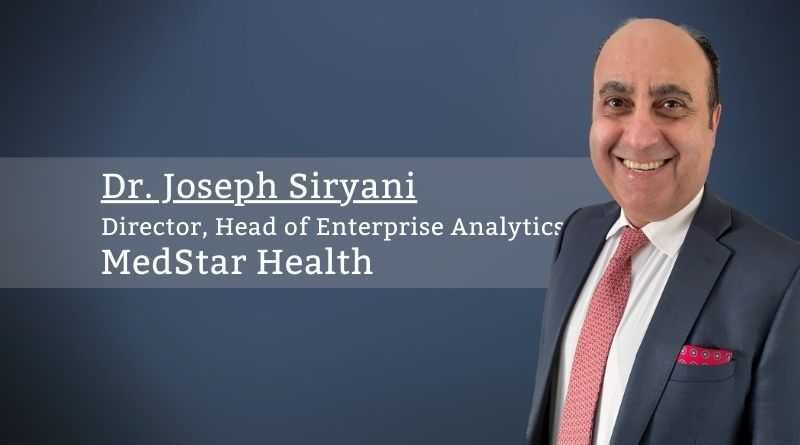Leveraging Augmented Intelligence To Improve Medical Imaging and Patient Outcomes
By Dr. Joseph Siryani, Director, Head of Enterprise Analytics, MedStar Health
As healthcare systems enter the era of unprecedented technological advances, healthcare executives may tap into an overwhelming number of state-of-the-art solutions that enable driving their digital transformation strategies forward. From mobile devices to skin-as-a-service, to augmented intelligence and machine learning, to cloud, to predictive and prescriptive analytics, to wearables, to telemedicine, and medical imaging; the options and opportunities are humongous.
Furthermore, as diagnostic and medical knowledge is accelerating at a high rate, leveraging AI on Medical Imaging will augment the radiologists and primary care physicians’ capacity and enable them to provide improved diagnostics, spotting patterns, calibrating risks, and providing decision support at an unparalleled pace with quality and accuracy.
Medical Imaging and AI Industry Overview
Technological advances in medical imaging, increased demand for sophisticated imaging systems to improve patient outcomes and operational efficiency, favorable regulatory scenario for medical imaging modalities, and growing usage of medical imaging in digital health will positively impact the market expansion.
Medical Imaging Market size is anticipated to grow at a CAGR of over 5.8% from 2021 to 2027, to surpass 58 billion USD. In 2020, it exceeded 38 billion USD, whereas, in terms of revenues, the global AI in medical imaging market was worth 384.7 million USD in 2019 and is expected to reach 20.11 billion USD by the end of 2031 at a CAGR of 36.1%.
Trends in Enterprise Imaging and PACS Systems
Picture Archiving and Communication Systems (PACS) and radiology enterprise imaging platforms have recently evolved in various ways to help enhance workflows such as streamlining integration of multiple data sources from various departments into the electronic medical record (EMR) to share images, as well as the addition of artificial intelligence (AI) to improve efficiencies.
As a continuation of this technology evolution, we observe the following trends and advancements:
- AI Integration into PACS and Enterprise Imaging Platforms: AI algorithms are being integrated into the backend of enterprise imaging systems or PACS. Among others, NVIDIA, Siemens, Philips, and Agfa have developed algorithms that identify the imaging protocol and correlate it to patient history.
- AI-driven smart workflow orchestrator to automate radiology reading lists: Orchestration generates order on reading lists where specific exams will be routed to the qualified radiologist to review. These systems further prioritize reads based on service level agreements (SLAs).
Applied AI in medical imaging has augmented the radiologists’ capabilities to recognize complicated patterns in imaging data and provide quantitative decision support.
How AI is Transforming Medical Imaging
The application of AI in medical imaging is fueling healthcare advances and is one of the most promising areas of care and medical innovation. Applied AI in medical imaging has augmented the radiologists’ capabilities to recognize complicated patterns in imaging data and provide quantitative decision support. In radiation oncology, AI has been applied to several unique image modalities used at different stages during the treatment. In medical imaging research, radiomics, that is the extraction of a significant number of image characteristics from radiation images, is currently very popular. Furthermore, AI applications has recently shown significant accuracy and precision in the classification of imaging field.
These novel innovations in diagnostic imaging, to both patients and physicians, implied improved care outcomes and contributed to the industry’s growth. Various innovations in several imaging modalities encompassing 3D imaging, ultrasound, magnetic resonance imaging (MRI), computed tomography (CT), mammography, as well as nuclear imaging contributed to the market shift towards patient-centric imaging and value-based radiology.
Potential Challenges of AI Adoption in Enterprise Imaging
Radiology is one of the most medical specialties poised for business transformation towards operational and administrative activities enabling clinician’s time back to work with their patients more closely, focusing on critical work.
However, this sometimes may be realized at the cost of some potential challenges. While these challenges are significant, they are yet addressable:
- Lack of knowledge of the enterprise imaging workflow, making some AI algorithms less usable in the workflows. To remedy this challenge, AI developers need to familiarize themselves with the clinical workflows prior to commencing the development of AI medical imaging solutions.
- Not sufficient adoption of radiology AI industry standards, resulting in the deployment of AI algorithms not being developed with imaging industry standards in mind, hence limiting the AI solution effectiveness. To mitigate this challenge, AI vendors need to elevate their medical imaging industry standards literacy prior to deploying AI.
Key Considerations When Developing an AI-based Medical Imaging Solution
- The key questions to answer are “how success will look like” as to the adoption of innovative medical imaging AI technology. More specifically, “what problem we are trying to solve in our patient care” and “how to integrate with our clinical workflow and operationalize it”.
- Compliance with regulatory standards, such as HIPAA, DICOM, FDA, and HL7 to address the legal use of data and disclosure of patient health information.
- Prioritize user experience and provide education assistance to accelerate the adoption and learning process thru elevating AI literacy and providing training and workshops.
Adoption of Innovative Technologies and Outlook
While we are implementing emerging technologies at MedStar Health, we are keen on institutionalizing their full adoption by sharing best practices and analytics solution information thru our MedStar Analytics Community forum, elevating literacy thru in-person and e-learning pertinent training to our healthcare analysts and users to make sure they are familiar with analytics technology use, understand the clinical workflow, and able to decipher the data to provide value.
In addition, by looking at the above key questions to answer, we continue to develop transformational innovative solutions that improve our care and patient outcomes across the care continuum.
Furthermore, from an enterprise perspective, we ingest data into our MedStar Analytics Platform from multiple data sources encompassing EMR, clinical, financial, operational, human resources, patient experience, quality & safety, and more which enable us to curate and enrich data and build data pipelines ready to deliver advanced analytics.



